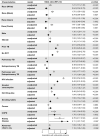Tuberculosis Burden and Determinants of Treatment Outcomes According to Age in Brazil: A Nationwide Study of 896,314 Cases Reported Between 2010 and 2019
- PMID: 34386510
- PMCID: PMC8354381
- DOI: 10.3389/fmed.2021.706689
Tuberculosis Burden and Determinants of Treatment Outcomes According to Age in Brazil: A Nationwide Study of 896,314 Cases Reported Between 2010 and 2019
Abstract
Approximately 1.4 million people die annually worldwide from tuberculosis. Large epidemiologic studies can identify determinants of unfavorable clinical outcomes according to age, which can guide public health policy implementation and clinical management to improve outcomes. We obtained data from the national tuberculosis case registry; data were reported to the Brazilian National Program (SINAN) between 2010 and 2019. Clinical and epidemiologic variables were compared between age groups (child: <10 years, young: 10-24years, adult: 25-64years, and elderly: ≥65years). Univariate comparisons were performed together with second-generation p-values. We applied a backward stepwise multivariable logistic regression model to identify characteristics in each age group associated with unfavorable TB treatment outcomes. There were 896,314 tuberculosis cases reported during the period. Tuberculosis incidence was highest among adult males, but the young males presented the highest growth rate during the period. Directly observed therapy (DOT) was associated with protection against unfavorable outcomes in all age groups. The use of alcohol, illicit drugs, and smoking, as well as occurrence of comorbidities, were significantly different between age groups. Lack of DOT, previous tuberculosis, race, location of tuberculosis disease, and HIV infection were independent risk factors for unfavorable outcome depending on the age group. The clinical and epidemiological risk factors for unfavorable tuberculosis treatment outcomes varied according to age in Brazil. DOT was associated with improved outcomes in all age groups. Incidence according to age and sex identified adults and young males as the groups that need prevention efforts. This supports implementation of DOT in all populations to improve tuberculosis outcomes.
Keywords: age; extrapulmonary TB; outcomes; pulmonary TB; tuberculosis.
Copyright © 2021 Barreto-Duarte, Araújo-Pereira, Nogueira, Sobral, Rodrigues, Queiroz, Rocha, Nascimento, Souza, Cordeiro-Santos, Kritski, Sterling, Arriaga and Andrade.
Conflict of interest statement
The authors declare that the research was conducted in the absence of any commercial or financial relationships that could be construed as a potential conflict of interest.
Figures






References
-
- World Health Organization . Global Tuberculosis Report 2020. (2020). 232 p.
-
- Martins-Melo FR, Bezerra JMT, Barbosa DS, Carneiro M, Andrade KB, Ribeiro ALP, et al. . The burden of tuberculosis and attributable risk factors in Brazil, 1990-2017: results from the Global Burden of Disease Study 2017. Popul Health Metrics. (2020) 18:10. 10.1186/s12963-020-00203-6 - DOI - PMC - PubMed
Grants and funding
LinkOut - more resources
Full Text Sources

